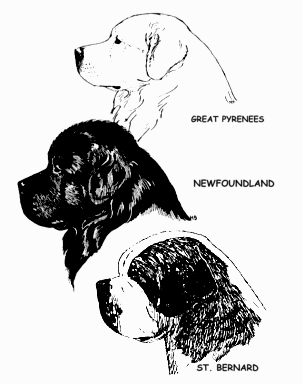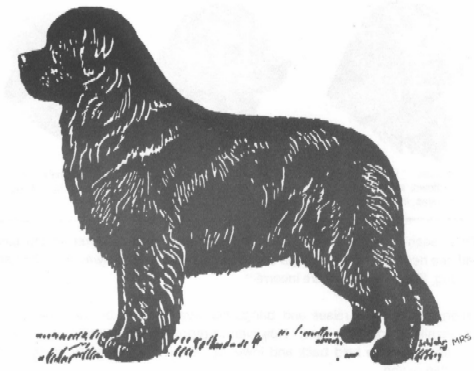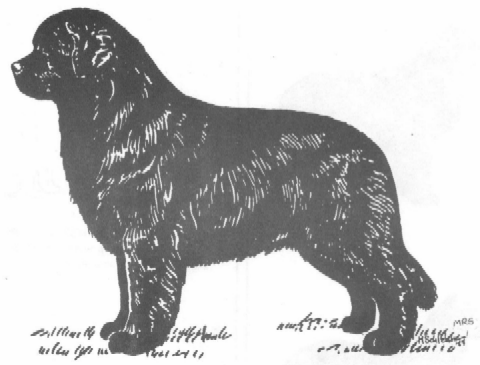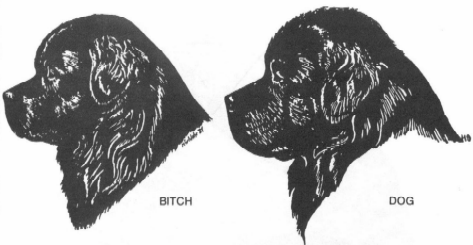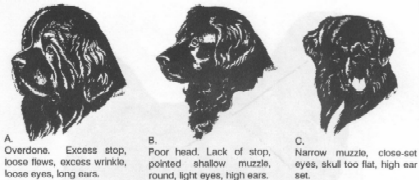

The "Ideal" Newfoundland
This web page will provide an overview of the Newfoundland breed standard set by the AKC (American Kennel Club), with guidance from the Newfoundland Club of America's Newfoundland Illustrated Guide.
The word ideal means "in accordance with the AKC standard for Newfoundlands". No dog is perfect; all dogs have faults. Breeders should, with every litter they produce, be striving to breed to the written standard.
The standard is meant to be a blueprint for the breed in regards to coat, muscle, bone, structure, temperament, and more. Conformation (dog show) is meant to prove your dog is worthy of being bred. The winners of these shows are the closest on that day to the AKC breed standard.
All images are presented in the Illustrated Guide and thus should receive due credit. In no way does the GLNC claim ownership, or claim to have created, these images below.
General Appearance
The Newfoundland is a sweet-dispositioned dog that acts neither dull nor ill-tempered. He is a devoted companion. A multipurpose dog, at home on land and in water, the Newfoundland is capable of draft work and possesses natural lifesaving abilities. The Newfoundland is a large, heavily coated, well balanced dog that is deep-bodied, heavily boned, muscular, and strong...
Quick Tips
Bred to save people, Newfoundlands exhibit a sense of dignity and honor, as well as enormous affection for it's person. By no means should the dog grow up to be shy or fearful of people.
A heavy coated, large body should not be confused with obesity. Weight and food intake should be monitored regularly to avoid health problems later in life.
Truly bred to work, Newfoundlands are wonderful for water rescue, cart and sled pulling, and more! However, not every Newf is born a great swimmer and most will need training and confidence from their owner. Likewise, with cart or sled pulling, expose your Newf to these new elements slowly and give them time to get comfortable with working with those objects.
Size, Proportion, Substance
...The dog's appearance is more massive throughout than the bitch's. Large size is desirable, but never at the expense of balance, structure, and correct gait. The Newfoundland is slightly longer than tall when measured from the point of shoulder to point of buttocks and from withers to ground. He is a dog of considerable substance which is determined by spring of rib, strong muscle, and heavy bone.
The average height for male Newfoundlands (often referred to as "dogs") 28 inches, with female Newfoundlands (often referred to as "bitches") average height being 26 inches. Weight for males range from 130 - 150 pounds with females being around 100 -120 pounds.
The Newfoundland should appear proportional all around, neither lanky nor overly thickset. Size is structure with height with both holding equal importance. Fat should not be confused with structure.
Newfoundlands are almost always slightly longer than they are tall.
Head (Eyes, Ears, Expression, Muzzle, Bite)
...Cheeks are well developed. Eyes are dark brown. (Browns and Grays may have lighter eyes and should be penalized only to the extent that color affects expression.) They are relatively small, deep-set, and spaced wide apart. Eyelids fit closely with no inversion. Ears are relatively small and triangular with rounded tips....
There is much that goes into the ideal Newfoundland head with the expression being a very important hallmark of the breed. The shape of the eyes is a major factor in the desirable sweet expression. Light eyes in browns and grays are not penalized, but a poor expression, whether due to eye color, shape, or placement, is not desired in dogs of any coat color.
It should be noted that a flat skull, too little stop from the muzzle to the head, flat cheeks, snipiness, or a "houndy look" all contribute to lack of "type" (the standard).
Desired Topline
Sway-backed ("dips in")
Low in Front
plain head, large ears. High rear, "shelly" body, tucked up, sleep rumps, straight rear angulation, cow hocked (back feet turned out, ankles in), weak feet.
Wrong topline, straight shoulders and upper arm, upright pasterns. Unbalanced.
Short neck, flat chest, belly tucked up, short legs

Neck, Topline, and Body
... The chest is full and deep with the brisket reaching at least down to the elbows....The tail is broad at the base and strong. It has no kinks, and the distal bone reaches to the hock. When the dog is standing relaxed, its tail hangs straight or with a slight curve at the end. When the dog is in motion or excited, the tail is carried out, but it does not curl over the back.
The neck should be long and strong enough to hold a proud head carriage. The chest should be full but not overly down while reaching down to the elbows at least. The croup (near the end of the back) is broad and slopes just slightly. The tail is long, strong and has no kinks, melding seamlessly with the croup. The tail can have a slight curve at the end when the dog is relaxed, but must be straight when at a gait.
A Newfoundland should not be sway-backed, hollow-backed or soft in the back, nor roached nor camel-backed. Grooming can make a fault topline appear level, or it can make a level back appear faulty, so the back must be felt to determine its true conformation and musculature. This is similar with the ribs, where it is not possible to tell from sight if substance is from proper rib spring or the dog being merely overweight.
Forequarters & Hindquarters
Forequarters - Elbows lie directly below the highest point of the withers. Forelegs are muscular, heavily boned, straight, and parallel to each other, and the elbows point directly to the rear. The distance from elbow to ground equals about half the dog's height. Feet are proportionate to the body in size, webbed, and cat foot in type. Dewclaws may be removed.
Hindquarters - The rear assembly is powerful, muscular, and heavily boned. Viewed from the rear, the legs are straight and parallel. Viewed from the side, the thighs are broad and fairly long. Stifles and hocks are well bent and the line from hock to ground is perpendicular. Hind feet are similar to the front feet. Dewclaws should be removed.
More often than not, a bad forequarter will equal bad "type" (standard) throughout the entirety of the dog. Muscular and heavily boned have equal importance, with the bones being proportionate to the size of the dog. A standard location to assess bone is the forearm, just above the pastern (the "thumb" on the front legs). A Newfoundland should never be faulted for having too much bone.
In terms of hindquarters, Newfoundlands should not be cow-hocked, sickle-hocked, barrel-legged, nor pigeon-toed in the rear. As the dog moves, you should be able to see the entire pad of the dog.
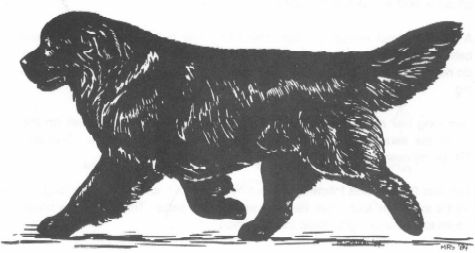
Coat & Gait
Coat - The adult Newfoundland has a flat, water-resistant, double coat that tends to fall back into place when rubbed against the nap. The outer coat is coarse, moderately long, and full, either straight or with a wave... The backs of the legs are feathered all the way down. Excess hair may be trimmed for neatness...
Gait - The Newfoundland in motion... gives the impression of effortless power. His gait is smooth and rhythmic, covering the maximum amount of ground with the minimum number of steps... When moving, a slight roll of the skin is characteristic of the breed. Essential to good movement is the balance of correct front and rear assemblies.
The Newfoundland coat should be cohesive with the purpose of the dog's historical work of protecting it from the harsh cold waters while rescuing people near it's native island of Newfoundland and Labrador, Canada. A kinky, curly, silky, or woolly coat is not wanted.
The speed at which most Newfoundland perform best at is a moderate trot. It should be powerful and intentional, which is prized over speed. Without a well balanced body, the gait will appear off and may further highlight faults of the dog.
Color
Color is secondary to type, structure, and soundness. Recognized Newfoundland colors are black, brown, gray, and white and black (Landseer).
Solid - Blacks, Browns, and Grays may appear as solid colors or solid colors with white at any, some, or all, of the following locations: chin, chest, toes, and tip of tail. Any amount of white found at these locations is typical and is not penalized. Also typical are a tinge of bronze on a black or gray coat and lighter furnishings on a brown or gray coat.
Landseer - White base coat with black markings. Typically, the head is solid black, or black with white on the muzzle, with or without a blaze. There is a separate black saddle and black on the rump extending onto a white tail.
Markings - Markings, on either Solid Colors or Landseers, might deviate considerably from those described and should be penalized only to the extent of the deviation. Clear white or white with minimal ticking is preferred. Beauty of markings should be considered only when comparing dogs of otherwise comparable quality and never at the expense of type, structure and soundness.
Color type should only affect the judgment of the Newfoundland in conformation if all dogs are comparable in type, structure, and soundness.
According to the American standard, acceptable colors are solid black, brown and gray. Landseer is a white Newfoundland with black markings. It is the only acceptable color combination where the Newfoundland is predominately white. Brown and white or gray and white Newfoundlands (where they are predominately white without question, see examples of #1, #2, #3 above) are to be disqualified. Solid white Newfoundlands are to be also disqualified.
The examples above, #1 - 8, are all acceptable markings of a black Newfoundland with white or a white Newfoundland with black. #1, #2, #3 highlight examples of "irish spots" and markings that are also acceptable in grays and browns.
Small black/brown/gray dots on white fur, called "ticking", is more prevalent in Landseers (as they are predominately white). Less to no ticking is preferred for the breed.
*Other colors and color combinations not mentioned above are not "rare" nor desirable. If someone states a certain color is rare and therefore "worth more money", do not believe them. There is no such thing. Examples can include, but are not limited to: any non-solid base color or markings such as merle, roan, or brindle, and black, brown, or gray base coat with markings other than white. Beige, tan, honey, buff, blond, or any pale shade of brown.

